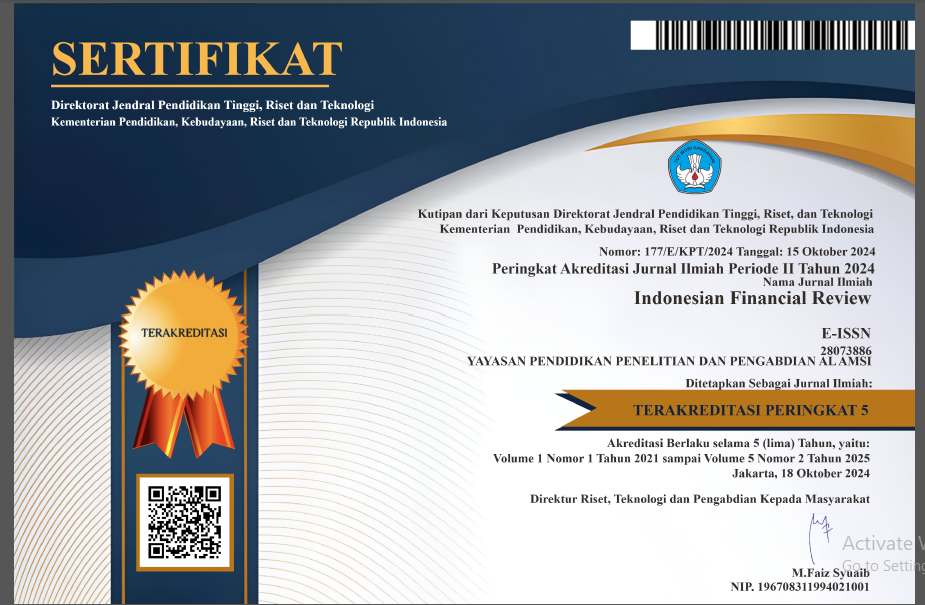
Author Guidelines
Author Charge
Author's charge is IDR 500.000
Waiver of Charge is free for foreign authors
The penalty of article's retraction is IDR 1.000.000
Manuscripts (click this link to download IFR Manuscript Template)
Manuscripts must be 1.5 line spacing on 21 cm x 29,7 cm paper. Body text should be written in Times New Roman, font size 12. Manuscript length should be reasonable for the contribution offered. With the submission of a manuscript, the following three items should be included in a separate page:
- Cover page showing title, each author’s name, affiliation, complete address, telephone and fax number, and the category of the article.
- Abstract of up to 150 words.
- Keywords, approximately five to seven words.
Manuscripts are reviewed by the editor, members of the IFR ditorial Review Board, and occasional reviewers. The author’s name and affiliation are removed before reviewing in order to ensure objectivity. Please do not identify the author(s) in the body of the paper either directly or by citation.
Section
Manuscript should be divided into five sections, i.e. Introduction, Literature Review, Research Method(s), Result(s) and Discussion(s), and Conclusion. Each section title should be written in Times New Roman, bold, font size 14. Sub-section should be written in Times New Roman, bold-italic, font size 12.
Introduction
The suggestions for the author's written of introduction are below:
- Clearly state your research question/hypothesis
- Clearly state whether your research question is new or innovative (different from literature)
- Provide well-articulated motivation for the research question.
- Support your research question with appropriate theory.
- Explicitly explain the approach taken to address research question in one paragraph.
- In one paragraph, provide summary of the findings.
- In two-three paragraphs, discuss the contribution of the paper in detail and be sure to cite appropriate studies.
- It is compulsory to conduct robustness tests and provide a summary of robustness check approach and findings.
Literature Review
- Literature review should summarize the key features of the literature. It should not be detailed study by study story telling.
- Authors are encouraged to use recent literature (papers published since 2017).
- Identify the gap in the literature that your study is filling.
Research Method(s)
- Data should be well described in tables and in graphs.
- Ensure to use econometric model consistent with those used in the related literature.
- Use recent methods (out-dated econometric methods on their own will not be considered).
- Methods (already published) should be summarised and supported by proper reference. Any modification to existing methods should be described and motivated in detail.
Result(s) and Discussion(s)
- Provide detailed discussion of results including elaborating the meaning of numbers reported in tables.
- Make a clear comparison of the results to the literature and identify the similarities and differences.
- Explain whether results relate to the theory and in which way.
Conclusion(s)
- Provide a short conclusion section outlining the main conclusions of the study.
- Conclusion section should stand alone and should not form a subsection of result discussion.
Acknowledgement(s)
The statement whom authors gratitude starting to the one who helping you the most. The help can be idea, data, fund, or else.
Reference(s)
The research should be used APA style.
Math Notation
Notations should be clearly explained within the text. Equations should be centered on the page. If equations are numbered, type the number in parentheses flush with the right margin. Unusual symbols and Greek letters should be identified. For equations that may be too wide to fit in a single column, indicate appropriate breaks.
Table and Figures
Table placements within text should be indicated. Camera-ready tables should be typed flush with the left-hand margin and have proper labeling of sources, column headings, and other notations. Once the manuscript has been accepted for publication, complex tables and figures (diagrams, charts, graphs, etc.) should be prepared professionally for camera-ready reproduction.
References
Reference citations within the text should consist of the author’s last name and date of publication, without punctuation, enclosed within parentheses, and should be inserted before punctuation and/or at a logical break in the sentence. If several citations are needed, separate them with semicolons, and list alphabetically. If two or more works by an author have the same year, distinguish them by placing a, b, etc. after the year.
References should be double-spaced and attached on a separate page. Works by single author, list chronologically; two authors, alphabetically and then chronologically; three authors, the same; four or more, list chronologically. References should be in the following (APA style):
Journal article, one author, accessed online
Merton, R. C. (1973). An Intertemporal Capital Asset Pricing Model. Econometrica, 41, 867–887. doi:10.2307/1913811
Journal article, two authors, accessed online
Roll, R., & Ross, S. (1980). An empirical investigation of the arbitrage pricing theory. The Journal of Finance, 35, 1073–1103. doi:10.2307/232708
Journal article, three or more authors, accessed online
Chen, N., Roll, R., & Ross, S. (1986). Economic Forces and the Stock Market. Journal of Business, 59, 383–403. doi:10.1086/296344
Journal article from a subscription database (no DOI)
Kumar, B., Singh, P., & Pandey, A. (2009). The dynamic relationship between price and trading volume: Evidence from Indian stock market. Retrieved from http://papers.ssrn.com/sol3/papers.cfm?abstract_id=1527562
Books, in print
Fabozzi, F. J., & Modigliani, F. (1996). Capital Markets: Institutions and Instrument (2nd ed.). New Jersey: Prentice Hall.
Article in a Book Edited by another Author
Hammond, K. R., & Adelman, L. (1986). Science, values, and human judgment. In H. R. Arkes & K. R. Hammond (Eds.), Judgement and decision making: An interdisciplinary reader (pp. 127-143). Cambridge: Cambridge University Press.
Research Reports and Papers
Mohammed, R. A. (2009). Analysis of Islamic Stock Indices (Unpublished magister dissertation). University of Waterloo, Canada.
For more information about APA style please visit www.apastyle.org, https://www.library.cornell.edu/sites/default/files/apa_2010.pdf, or https://owl.english.purdue.edu/owl/resource/560/01/.
Submission Preparation Checklist
As part of the submission process, authors are required to check off their submission's compliance with all of the following items, and submissions may be returned to authors that do not adhere to these guidelines.
- Aim and Scope:
- The authors' topic is in line with Indonesian Financial Review's aim and Scope.
- Abstract and Keywords:
- JEL Classification: G
- Abstract consists of 150 words (maximum) and keywods cover approximately five to seven words.
- Section/Heading Format:
- Introduction
- Literature Review
- Research Method(s)
- Result(s) and Discussion(s)
- Conclusion
- Acknowledgement
- References
- Manuscript is divided into seven sections, i.e.
- Citation and References:
- References comply to the APA citation style. Citations in the body text appear in the references, and vice versa.
Privacy Statement
The names and email addresses entered in this journal site will be used exclusively for the stated purposes of this journal and will not be made available for any other purpose or to any other party.
JEL Classification
|
G1 |
General Financial Markets |
|
|
G10 |
General |
|
|
G11 |
Portfolio Choice • Investment Decisions |
|
|
G12 |
Asset Pricing • Trading Volume • Bond Interest Rates |
|
|
G13 |
Contingent Pricing • Futures Pricing |
|
|
G14 |
Information and Market Efficiency • Event Studies • Insider Trading |
|
|
G15 |
International Financial Markets |
|
|
G17 |
Financial Forecasting and Simulation |
|
|
G18 |
Government Policy and Regulation |
|
|
G19 |
Other |
|
|
|
||
|
G2 |
Financial Institutions and Services |
|
|
G20 |
General |
|
|
G21 |
Banks • Depository Institutions • Micro Finance Institutions • Mortgages |
|
|
G22 |
Insurance • Insurance Companies • Actuarial Studies |
|
|
G23 |
Non-bank Financial Institutions • Financial Instruments • Institutional Investors |
|
|
G24 |
Investment Banking • Venture Capital • Brokerage • Ratings and Ratings Agencies |
|
|
G28 |
Government Policy and Regulation |
|
|
G29 |
Other |
|
|
|
||
|
G3 |
Corporate Finance and Governance |
|
|
G30 |
General |
|
|
G31 |
Capital Budgeting • Fixed Investment and Inventory Studies • Capacity |
|
|
G32 |
Financing Policy • Financial Risk and Risk Management • Capital and Ownership Structure • Value of Firms • Goodwill |
|
|
G33 |
Bankruptcy • Liquidation |
|
|
G34 |
Mergers • Acquisitions • Restructuring • Corporate Governance |
|
|
G35 |
Payout Policy |
|
|
G38 |
Government Policy and Regulation |
|
|
G39 |
Other |
|
|
|
||
|
G4 |
Behavioral Finance |
|
|
G40 |
General |
|
|
G41 |
Role and Effects of Psychological, Emotional, Social, and Cognitive Factors on Decision Making in Financial Markets |
|
|
|
||
|
G5 |
Household Finance |
|
|
G50 |
General |
|
|
G51 |
Household Saving, Borrowing, Debt, and Wealth |
|
|
G52 |
Insurance |
|
|
G53 |
Financial Literacy |
|
|
G59 |
Other |
|














